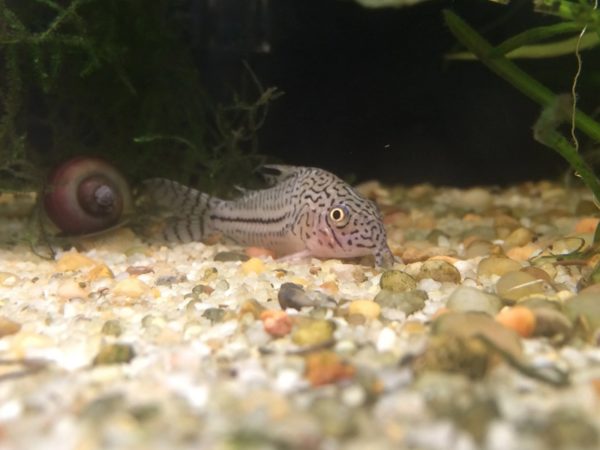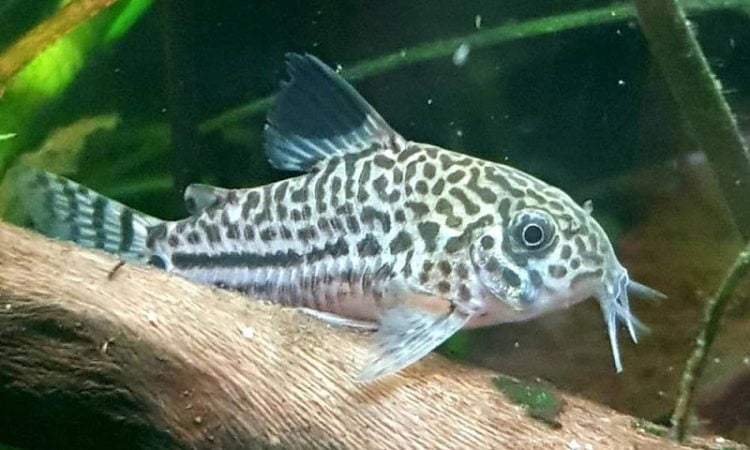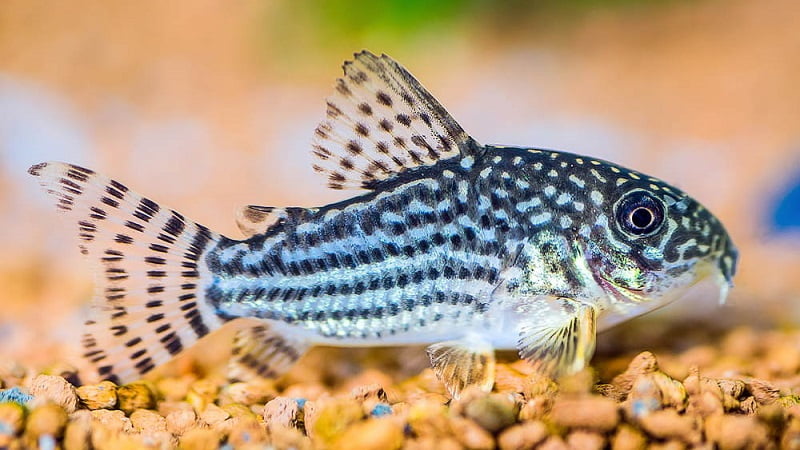Why is my cory catfish look lethargic? You may come up with this question when noticing your cory catfish staying still, laying on their sides, and not showing any interest in food. There are several external factors resulting in a lethargic cory catfish.
Their lethargic status could signify illness, stress, loneliness, or simply a resting behavior. Therefore, you should carefully observe their behavior in the following several days.
To help you be aware of lethargic cory catfish in your aquarium, I’ve listed 9 causes below and also included some prevention notes that assist you in keeping your fish healthy.
9 Causes For Lethargic Cory Catfish
Injuries
You should be concerned if your corys spend a lot of time staying still, hiding most of the time, and not eating because it might indicate that your corydoras get injured.
Whenever possible, catch your lethargic cory catfish and check their entire body for any wounds. They can get sores from scraping against rocks or other fish, but these can be hard to spot until the wounds get severe.
Infection or sickness
Unmoving cory catfish might mean your fish is suffering from infections or sickness since they need to move to stay healthy and happy. The first step you should take when trying to find out if your cory catfish gets ill is to look for any injuries all over their body.
If there are physical injuries (torn tail and fins or bulging eyes), quarantine and treat them with appropriate medicines to help them recover quickly. Besides, leaving such damages untreated allows parasites, bacteria, and fungi to attack the open wounds and make your corydoras sick.
If you do not see any obvious signs of damage or notice that the intestines of your cory have been chewed away, it may suffer from Columnaris.
A scratch by gravel or rocks in the tank is the most likely cause of Columnaris on your cory catfish. If not spotted and treated, this disease can be transmitted throughout your aquarium, infecting all other fish.
Resting status
Usually, your cory catfish stop moving and look lethargic just because they are exhausted and need to rest and recharge energy. When they restore their energy, they will usually resume their activity.
As many bottom-feeders, your corydoras buddies will spend all day scavenging the aquarium bottom. Because this task requires a lot of energy and time, they must rest periodically.
Cory catfish are active and friendly fish. When housed with groups of their own species, they will spend time playing with each other and eventually get tired. You will see that they often take a short break after a long playing time. This is normal, so you don’t need to be concerned.
But if they “rest” for several hours or days, at this point, you should immediately check if there are any problems with their health and their tank.

Cre: halfriver on Reddit
Inappropriate water parameters
Corydoras are tropical freshwater fish, and the water range for them to live healthily is 72-82˚F. If your home aquarium has a water temperature of more than 82˚F, your corys will become lethargic and display a loss of appetite. In this case, your fish will have to work hard to cool their bodies by urgently releasing heat using their gills.
Therefore, you should put your lethargic cory catfish in cooler water, below 82˚F, for them to be able to heal naturally. After two weeks in a colder tank, if they do not seem to be recovering, there is a probability of other problems in your tank.
Additionally, poor water quality can contribute to the lethargic status of corydoras. Dirty water with a high ammonia level and unsuitable pH often causes them to refuse to eat, decrease their activity level, and even get sick.
Therefore, you should check your tank water quality to ensure this isn’t the problem because fish illnesses can spread quickly in a community tank.
Inappropriate tank setting
Cory Catfish will feel frustrated and depressed if they are housed in an unsuitable tank setting and eventually cease to move. Bottom-dwelling species like cory catfish eat substrate and aquarium gravel, so the tank’s bottom should have at least two inches of gravel.
A planted tank with lots of live plants is also beneficial to a cory catfish because the aquarium plants give them a place to hide and shelter. It is necessary to include ornaments and pebbles to encourage their exploration activity.
Loneliness
A lethargic cory catfish might indicate that it is suffering loneliness since corydoras are sociable, especially within their own species. Although corys can survive on their own, they seem to do better in groups.
Two cory catfish of the same species often stay near one another as they wander around the tank to feed. The situation is particularly true when they are sleeping.
If you keep a single cory catfish in your tank and eventually notice it stops swimming and playing, this might be a sign of an unhappy or lonely corydoras. So, it’s time to get more corys for your tank to make your buddy happy and comfortable. The recommended number for a group of the same cory catfish species is at least 6.
Besides, for a newly introduced cory catfish, it will look lethargic and inactive because they need time to get used to the new tank environment. In this case, I will recommend increasing the number of individuals of that corydoras species to make it feel safe.
Unsuitable tank mates
Unsuitable tank mates can make your cory catfish appear to be lethargic. When being chased by larger or aggressive tank mates, they will stay still at the bottom of a tank and try to hide from them. Terrified cory catfish will likely be inactive and less sociable.
So, choosing suitable tank mates for cory catfish is important. Their good tank mates are those with a calm temperament and are not much larger than them.
Moreover, mixing different species of corydoras could make your cory catfish feel unease because of insufficient shoaling of its own species.
Different corys will display different behaviors and characters. Some may appear to be bigger eaters than others, causing competition over food. Some will be more active than others and “disturb” their mates.
Therefore, you should keep at least six individuals of the same corydoras species. If your tank is not big enough, try to keep your cory catfish in pairs.
Lack of space
Lack of space or overcrowding tank is another critical cause for lethargic cory catfish. Fish will cramp and get stressed and aggressive if they live in a crowded environment, threatening other timid cory catfish.
Thus, providing enough space for your fish is vital to keep them healthy. Large tanks are ideal because cory catfish prefer living in groups. If you have a small group of corydoras, a 20-gallon long tank is acceptable, but a larger tank is always better.
Lack of essential nutrients
A lethargic cory catfish might be the result of an insufficient-nutrient diet. Fish flakes, pellets, and bottom feeder tablets are some of the basic foods that a cory catfish eats. The corys will scour the tank bottom for hours searching for food and even dig the surface gravel with their jaws.
Without enough nutrients, the corys are likely to stop moving and start swimming in place. It would help if you modified their meal to include extra nutrients based on their dietary needs.

Important Notes For Treating & Preventing Lethargic Cory Catfish
- Take immediate actions to determine the cause of inactive cory catfish if you notice them do not move or eat for several days. This might be a sign of sickness.
- Immediately move the sick cory catfish to a hospital tank and use suitable medicines while keeping the clean and ideal water environment for the best recovery.
- Check the water parameters regularly, especially when you spot your fish’s inactivity.
- Do regular water changes to remove uneaten food and other wastes.
- Keep a stable pH level and water temperature.
- Quarantine the new fish for several days to ensure they are healthy before introducing them to your aquarium.
- Keep at least 5-6 individuals together and with suitable tankmates to make them feel safe and avoid stress.
- Provide a rich-nutrient diet with a variety of foods like frozen artemia or cyclops.
FAQs
Do cory catfish play dead?
The cory catfish may sometimes act dead, which may scare any owner passing by.
When they are sick or feel threatened, corydoras will fake their death to hide from predators. This is how they prevent being eaten or attacked when they’re recuperating from illness or stress.
Why is my cory catfish lethargic and not eating?
Many things can cause your fish to appear tired and sluggish. One of the most common causes is an incorrect water temperature. Too hot or too cold tank water can result in lethargic cory catfish. Make sure your heater is set to the proper temperature for your aquarium.
Other possible causes for your lethargic cory catfish include overfeeding and poor water quality.
Why is my cory catfish gasping for air at the surface of the tank?
Cory catfish usually swim to the top of the tank because stagnant water and high temperatures deprive them of oxygen. However, due to high ammonia concentrations or swim bladder conditions that affect their buoyancy, certain catfish will reside in the upper parts of the tank.
When there is a major of cory catfish gasping for air at the top of their aquariums, this could be an indication that either the water quality is poor or the dissolved oxygen levels are inadequate. At this time, you should test your water parameters and consider installing a tank aerator.
Conclusion
Cory catfish lethargy can be the initial symptom of sickness or infections, so you should be aware of this. But there are times they just stay still to rest after enjoying wandering or playing with others in the tank.
So, to tell whether they get an infection or just resting, you should carefully observe them for several days. Also, ensure good water quality with clean aquarium environments and feed them nutrient-sufficient foods, which helps avoid stress and makes them healthy.

Annette M. Chaney is an experienced marine biologist with over 20 years of experience as an aquarist and fishkeeper. She started her first aquarium at a young age, filling it with frogs and goldfish obtained from the ten-cent pet store.
Annette grew up caring for and breeding African Cichlids, which led to a hobby in high school that doubled as a profitable means. Attending Reed College gave her time to solidify herself as an accomplished aquarium caretaker with an eye for sales. After that, from 2009 – 2013, she studied at Roger Williams University – one of the most prestigious universities for Aquaculture and Aquarium in USA. She is the founder of AquariumCircle since 2010.
